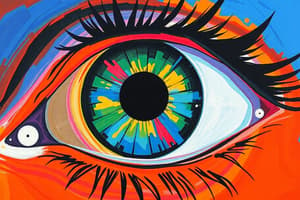Podcast
Questions and Answers
What is the main purpose of LASIK eye surgery?
What is the main purpose of LASIK eye surgery?
- To replace the natural lens of the eye with an artificial one
- To improve night vision
- To remove the cornea completely
- To reshape the cornea to focus light directly on the retina (correct)
Which vision problems can LASIK eye surgery correct?
Which vision problems can LASIK eye surgery correct?
- Myopia, Hyperopia, and Astigmatism (correct)
- Glaucoma
- Retinal detachment
- Color blindness
How long does a typical LASIK eye surgery procedure take?
How long does a typical LASIK eye surgery procedure take?
- 2 hours
- 1 hour
- 30 minutes
- 15 minutes (correct)
What instrument is commonly used to remove some corneal tissue during LASIK surgery?
What instrument is commonly used to remove some corneal tissue during LASIK surgery?
In LASIK surgery, how does the surgeon adjust the cornea for myopic vision?
In LASIK surgery, how does the surgeon adjust the cornea for myopic vision?
Which type of lens is implanted during Toric Implantable Collamer Lens ICL surgery?
Which type of lens is implanted during Toric Implantable Collamer Lens ICL surgery?
What type of vision problem is Presbyopia associated with?
What type of vision problem is Presbyopia associated with?
Keratoplasty is recommended for what condition when astigmatism is associated with central corneal opacity?
Keratoplasty is recommended for what condition when astigmatism is associated with central corneal opacity?
Why does the lens lose elasticity as people age in terms of Presbyopia?
Why does the lens lose elasticity as people age in terms of Presbyopia?
Flashcards are hidden until you start studying
Study Notes
Normal Refraction
- The total refractive power of a normal eye (emmetropic eye) is 60 Diopters (D), divided between the cornea (43D) and the lens (17D).
- An emmetropic eye is one in which parallel rays of light tend to focus directly on the retina when the eye is at rest.
Accommodation
- Accommodation is the contraction of the ciliary muscle to increase the curvature of the lens, increasing its refractive power to visualize objects closer than 6 meters.
- Amplitude of accommodation is the difference in the converging power of the eye between maximum accommodation and unaccommodated eye, which depends on the strength of contraction of the ciliary muscles and elasticity of the lens capsule.
Refractive Errors (Ametropia)
- There are three types of refractive errors: Hypermetropia, Myopia, and Astigmatism.
Myopia (Short-sightedness)
- Myopia is a refractive error where parallel rays of light come to a focus in front of the retina when the eye is at rest.
- Causes of myopia: increase in converging power of the eye or increase in AP diameter (> 24 mm).
- Symptoms: blurred distant vision, headache, fatigue, and nausea.
- Treatment: concave lenses, contact lenses, photorefractive surgery, and Implantable Collamer Lens (ICL).
Hypermetropia (Far-sightedness)
- Hypermetropia is a refractive error where parallel rays of light are brought to a focus behind the retina when the eye is at rest.
- Causes of hypermetropia: decrease in converging power of the eye or decrease in AP diameter (< 24 mm).
- Symptoms: blurred vision, eye strain, headache, fatigue, and nausea.
- Treatment: convex lenses, contact lenses, laser photorefractive surgery, and Implantable Collamer Lens (ICL).
Astigmatism
- Astigmatism is a refractive error where a point of focus of light cannot be formed upon the retina, resulting in two or more focal lines.
- Causes of astigmatism: unequal curvature of the cornea or lens, decentration of the lens, and index astigmatism.
- Treatment: cylindrical lenses, contact lenses, photorefractive laser surgery, toric Implantable Collamer Lens (ICL), and keratoplasty.
Presbyopia
- Presbyopia is a form of far-sightedness that makes it harder for people to read as they age due to loss of elasticity of the lens.
- Corrected by glasses with converging lenses.
LASIK Eye Surgery
- LASIK eye surgery is used to correct vision problems such as Myopia, Hyperopia, and Astigmatism.
- The procedure involves reshaping the cornea using an excimer laser to focus light directly on the retina.
Studying That Suits You
Use AI to generate personalized quizzes and flashcards to suit your learning preferences.




